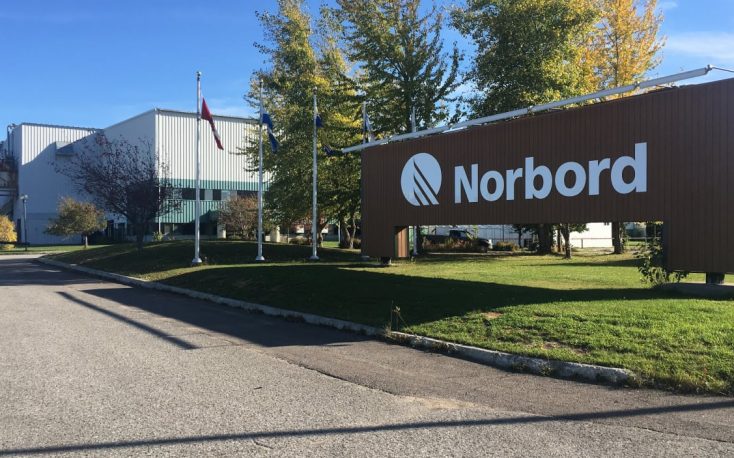Norbord Inc. reported Adjusted EBITDA of $273 million for the second quarter of 2018 versus $165 million in the second quarter of 2017 and $170 million in the first quarter of 2018. The 65% year-over-year improvement is primarily due to higher North American oriented strand board (OSB) prices and shipment volumes, as well as higher European panel prices. North American operations generated Adjusted EBITDA of $256 million compared to $157 million in the same quarter last year and $156 million in the prior quarter. European operations delivered Adjusted EBITDA of $21 million versus $9 million in same quarter last year and $18 million in the prior quarter.
“Our second quarter results are the highest in the Company’s history,” said Peter Wijnbergen, Norbord’s President and CEO. “We generated $273 million in Adjusted EBITDA, a huge improvement over this time last year as our North American mills shipped 10% more OSB in a strong market environment. Our European business delivered $21 million of Adjusted EBITDA, its best result ever in local currency terms, as robust demand growth in our key markets supported strong prices.”
“We expect that OSB demand will continue increasing and Norbord is investing in incremental future capacity through a number of capital projects. Our 2018 capital expenditures are now forecast at $200 million and include projects at our mills in Chambord, Quebec, Grande Prairie, Alberta and Huguley, Alabama. We believe these prudent investments will ensure that we are ready to meet customers’ growing needs in the years ahead.”
Market Conditions
In North America, year-to-date US housing starts were up 8% versus the same period in 2017, with single-family starts, which use approximately three times more OSB than multifamily, also increasing by 8%. The consensus forecast from US housing economists is for approximately 1.31 million starts in 2018, which suggests a 9% year-over-year improvement.
North American benchmark OSB prices increased significantly during the second quarter of 2018 as end-use demand remained robust during the prime spring homebuilding season. Average benchmark prices were significantly higher than both the prior quarter and the same quarter last year. The North Central benchmark OSB price was steady through April, increased in May before stabilizing at its year-to-date high of $445 per Msf (7/16-inch basis) for all of June. The logistics challenges that first materialized in the Western Canadian region during the first quarter began to ease late in the second quarter. As a result, the Western Canadian benchmark price finished the quarter below the North Central benchmark, but was still 12% higher on average quarter-over-quarter. The table below summarizes average benchmark prices ($ per Msf, 7/16-inch basis) by region for the relevant quarters:
In Europe, panel markets continued to strengthen, driven by robust OSB demand growth in Norbord’s core markets. In local currency terms, average panel prices were up 27% versus the same quarter last year and up 5% from the prior quarter.
Performance
North American OSB shipments increased 9% year-over-year and 10% quarter-over-quarter due to seasonally higher productivity and uptime, as well as additional production from the Huguley, Alabama mill that restarted during the fourth quarter of 2017. Norbord’s specialty sales volume (including industrial applications and export markets) increased by 9% year-over-year and represented approximately 25% of the company’s North American OSB sales volume.
Excluding the curtailed Chambord, Quebec mill, Norbord’s operating North American OSB mills produced at 98% of stated capacity, compared to 99% in the same quarter last year and 94% in the prior quarter. Capacity utilization declined slightly year-over-year due to the inclusion of the Huguley mill, which remains in ramp-up mode following its restart in late 2017. Quarter-over-quarter, capacity utilization increased due to improved productivity and seasonally faster line speeds compared to the particularly harsh winter weather conditions in the first quarter.
In May, the company temporarily suspended production at its OSB mill in 100 Mile House, British Columbia for approximately three weeks due to a temporary wood shortage. The significant wildfires that the province of British Columbia experienced in the summer of 2017 seriously damaged logging areas surrounding the 100 Mile House mill. Further, the severe weather conditions this winter limited loggers’ ability to access the forests during the months when the mill typically builds its annual log inventory.
Norbord’s North American OSB cash production costs per unit (before mill profit share) increased 5% compared to the same quarter last year due to the stronger Canadian dollar as well as higher resin and fibre prices, partially offset by improved productivity and the timing of annual maintenance shuts and related costs. Unit costs decreased 4% versus the prior quarter due to improved productivity and raw material usage, partially offset by higher fibre prices. Higher fibre prices versus both comparative periods are primarily due to the impact of last year’s wildfire season on the 100 Mile House mill’s wood supply.
In Europe, Norbord’s shipments were 6% lower than the same quarter last year and 3% lower than the prior quarter due to shipment timing. The European mills produced at 89% of stated capacity in the quarter compared to 105% in the same quarter last year and 86% in the prior quarter. Capacity utilization increased quarter-over-quarter due to improved productivity, but decreased year-over-year due to the restated annual production capacity to reflect the new OSB continuous press line at the Inverness, Scotland mill that was substantially completed in the fourth quarter of 2017. Production from the expanded Inverness mill will not significantly increase until 2019 when the new finishing line installation and commissioning are complete.







Leave a Reply